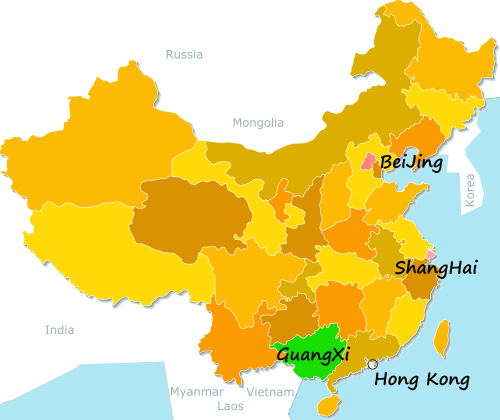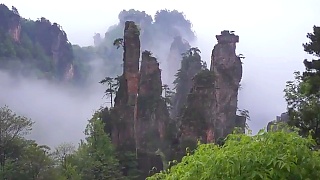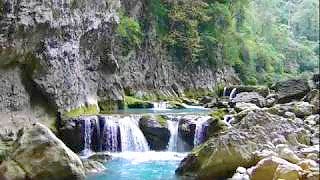
|
XiaoQiKong Scenic Area, LiBo, GuiZhou : A Visitor’s Guide
The Xiaoqikong Scenic Area, or "Seven Small Arches," is a UNESCO World Heritage site located in Libo County, Guizhou Province. This breathtaking natural haven is famous for its karst landscapes, dense forests, crystal-clear rivers, and historic stone bridges. Its name derives from a 19th-century stone bridge with seven arches, which is the centerpiece of the park.
How to Get There
By Air:
The nearest airport is Libo Airport, which has flights from major cities like Guiyang. From the airport, it's about an hour's drive to the scenic area.
By Train:
Libo is accessible via high-speed rail. From the Libo Railway Station, take a taxi or local bus to Xiaoqikong.
By Bus:
Direct buses from Guiyang or other nearby cities to Libo are available. From Libo town, a short local bus or taxi ride will bring you to the park.
Entrance and Fees
Opening Hours: 8:00 AM – 5:30 PM (varies by season).
Admission Fee: Approximately 110–150 RMB (varies depending on the season and package options, including shuttle services).
Top Attractions in Xiaoqikong Scenic Area
1. The Seven Small Arches Bridge
Overview: This Qing Dynasty stone bridge, with seven small arches spanning a turquoise river, is the park's namesake and one of its most iconic sights.
Don’t Miss: The surrounding waters reflect lush greenery, creating a picture-perfect scene for photography.
2. The Water Forest
Unique Feature: Trees grow directly out of the water in this surreal wetland area. The intertwining roots and crystal-clear streams create an enchanting atmosphere.
Activities: Walk along the wooden pathways and admire the unique ecosystem.
3. 68-Level Waterfalls
Description: A cascading series of small waterfalls stretch over several kilometers, forming a mesmerizing chain of white foam and turquoise pools.
Tip: Visit early in the morning for fewer crowds and better lighting for photos.
4. Green Canyon (Lushui Valley)
Highlight: This narrow canyon is filled with lush vegetation and dramatic karst formations.
What to Do: Follow the trail that winds through the canyon for stunning views of cliffs, caves, and water features.
5. Mandarin Duck Lake
Why Visit: A serene lake surrounded by dense forest, where you can spot pairs of mandarin ducks and other waterfowl.
Activities: Rent a boat to explore the lake or enjoy a picnic on its shores.
6. The Ancient Banyan
Feature: A massive banyan tree with sprawling roots and branches that provide a mystical and serene setting.
Significance: This is one of the oldest trees in the area, revered by locals.
7. Qinglong Waterfall
Overview: A grand waterfall set amidst lush green cliffs.
What to Do: Hike up to the viewing platform for the best angle of this magnificent cascade.
Activities and Experiences
Hiking Trails:
The park features several well-maintained trails, ranging from easy walks to more challenging hikes.
Most trails pass through diverse landscapes, from karst caves to dense bamboo forests.
Boat Rides:
Enjoy scenic boat rides on Mandarin Duck Lake or the surrounding waterways.
Wildlife Spotting:
The area is home to diverse flora and fauna, including rare species like the Guizhou golden monkey and colorful butterflies.
Photography:
The vibrant turquoise waters, lush greenery, and karst formations make Xiaoqikong a photographer’s paradise.
Local Cuisine
Rice Noodles (Mixian):
A staple dish in Guizhou, served in rich broth with fresh herbs and spices.
Sour Fish Soup:
A tangy and spicy local specialty made with freshwater fish.
Sticky Rice Dumplings:
Perfect for a quick snack while exploring.
Wild Vegetable Dishes:
Many restaurants in the area use locally foraged vegetables, prepared simply to highlight their natural flavors.
Best Time to Visit
Spring (March–May): The park is lush and vibrant, with waterfalls at their fullest due to seasonal rains.
Autumn (September–November): Cooler weather and the surrounding forest's changing colors make this the most picturesque season.
Tips for Visitors
Transportation Within the Park:
Shuttle buses are available for an additional fee and are highly recommended to cover the large area efficiently.
Clothing:
Wear comfortable walking shoes and pack layers, as the weather can change quickly in the mountains.
Photography Gear:
Bring a waterproof bag for your camera or phone, as many attractions involve water.
Stay Hydrated:
Carry water, especially if hiking longer trails, as shops may not be available in remote areas.
Crowds:
Visit early in the morning or during weekdays to avoid peak tourist times.
Nearby Attractions
Daqikong Scenic Area:
A complementary park nearby with its own set of natural wonders, including deeper gorges and caves.
Libo Zhangjiang Scenic Spot:
Another UNESCO World Heritage site featuring pristine rivers and karst landscapes.
Ethnic Villages:
Visit local Buyi, Miao, and Shui villages to experience traditional customs, architecture, and festivals.
Xiaoqikong Scenic Area is a destination where natural beauty, tranquility, and adventure come together. Whether you're an avid hiker, a nature lover, or a history enthusiast, this scenic area offers something unique and unforgettable.
|

 The beautiful karst landscape around GuiLin 桂林
The beautiful karst landscape around GuiLin 桂林
 The beautiful karst landscape around GuiLin 桂林
The beautiful karst landscape around GuiLin 桂林





